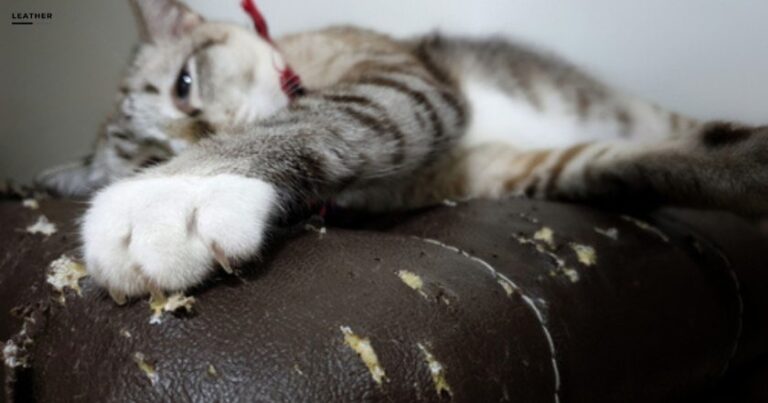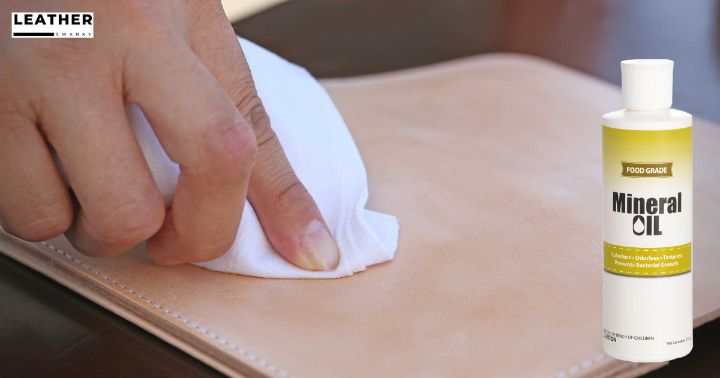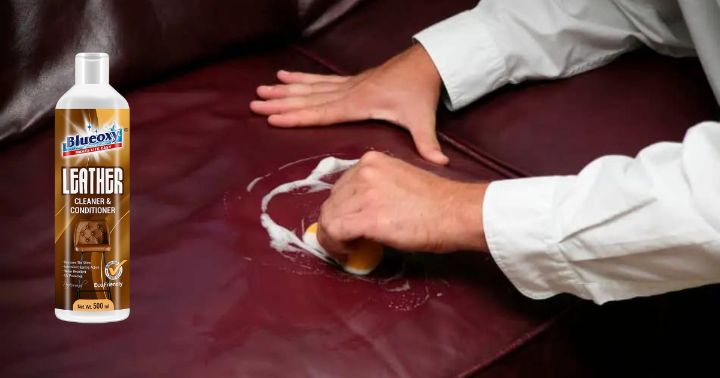How to Remove Paint From Leather? 7 Best Ways

Leather is a material that requires special care when cleaning up messes, particularly when it comes to paint. You don’t want to damage the leather or leave any traces of paint behind.
To remove paint from leather, start by cooking oil, warm water, soapy water, soft bristled brush, rubbing alcohol, fingernail polish, petroleum jelly and more.
In this article, you’ll find effective ways how to remove paint from leather, as well as dos and don’ts and additional tips for making sure your leather looks great.
Jump to a Specific Section
Summary
- Test cleaning products on an inconspicuous area of the leather first.
- Use a cleaning solution specifically designed for leather.
- Be gentle when scrubbing and avoid using harsh detergents or bleach.
- After removing the paint, apply a conditioning cream or oil to preserve the leather’s quality and appearance.
Things You’ll Need
You’ll need a few supplies to remove paint from leather, so make sure you have them on hand.
- Gather baby oil
- Commercial leather cleaner
- Cloth for removing the paint
- Leather conditioner
How to Remove Paint from Leather? 7 Ways
The best way to start is by using cooking oil, warm water, and a soft-bristle brush; followed by soapy water and rubbing alcohol if the paint is more stubborn.
1. Cooking Oil
This technique is gentle and effective for removing any oil-based paints without damaging the delicate leather surface.
The cooking oil will help dissolve the paint, making it easier to clean off while protecting your leather item from damage.
Be sure to rinse off the cooking oil after you’re done cleaning so that no residue is left behind that can discolor or otherwise harm the leather material.
2. Warm Water
Washing the leather with warm water is an important step in ensuring that all paint residue is gone.
To begin, dampen a clean cloth with lukewarm water and gently wipe the leather surface to remove any remaining paint stains. Be sure not to scrub too hard as this could damage the delicate leather material.
You may need to repeat this process multiple times until you have removed as much of the paint as possible.
Afterward, use a dry, clean cloth to pat down any excess moisture and leave it out in a well-ventilated area until completely dry.
3. Soapy Water
Cleaning the leather surface with a soapy water solution is an effective way to get rid of any remaining paint residue.
When removing paint from leather shoes, it’s important to make sure you use a gentle soap in order to not damage the material.
Here are some tips for using soapy water:
- To get fresh paint off, use lukewarm water mixed with a small amount of dishwashing soap and rub in a circular motion until it comes off
- For more stubborn dried paint, apply a paste made from equal parts dishwashing soap and baking soda
- Once the paint has been removed completely, dry the area thoroughly using a clean cloth
Using soapy water will help you remove paint from leather shoes safely without ruining its texture or color.
4. Soft Bristled Brush
This will help break down any stubborn bits of paint that are still clinging to the leather.
When selecting a brush, make sure it is gentle enough for the delicate leather material and won’t cause any damage.
You may also need to apply some cleaner with your brush if needed in order to lift off any remaining residue.
5. Rubbing Alcohol
Once you’ve finished brushing the area, rubbing alcohol can help lift away any remaining traces of color.
To do this, first, dampen a soft cloth with rubbing alcohol and gently rub it on the affected area in circular motions.
This will help to remove any paint stains and prepare the surface for an appropriate leather cleaner or conditioner.
Here’s what you should keep in mind:
- Use only light pressure when cleaning
- Test a small spot of leather first before applying it to large surfaces
- Wipe away excess liquid with a microfiber cloth
With careful attention given to these steps, your leather will be ready for conditioning and shine as good as new.
6. Fingernail Polish
For paint stains from leather, using nail polish remover is an effective way to remove them.
To start, use a cotton swab or cotton pad moistened with the nail polish remover and gently rub the paint away.
Different materials require different techniques for removing fingernail polish from leather:
| Material | Technique | Effectiveness |
|---|---|---|
| Leather | Rub gently w/ nail polish remover & soft cloth | Moderate effectiveness; may take multiple attempts. |
| Suede | Use nail polish remover & brush in a circular motion | High effectiveness; usually only one attempt is necessary. |
Using these techniques, you should be able to safely remove the paint stain from your leather material and maintain its integrity.
7. Petroleum Jelly
It is an effective way to tackle those stubborn spots on leather surfaces.
It’s gentle enough to remove a variety of paints without damaging the leather material, but it requires patience and careful technique in order to be successful.
Here are some ways you can use petroleum jelly to remove paint from leather:
- Apply a thin layer of petroleum jelly over the affected area and let it sit for several hours.
- Gently rub the area with a soft cloth or sponge until most of the paint has been removed.
- Condition the leather afterward with a quality leather conditioner.
Removing Different Types of Paint
Depending on the type of paint, you will need to use different methods to ensure that the leather is not damaged during the process.
Whether it’s wet or dried, acrylic or water-based, or oil-based paints, with just a few simple steps, you can make sure your leather stays looking beautiful and clean.
So let’s take a look at how to safely and effectively remove each type of paint from your leather.
1. Removing Wet Paint from Leather
It can be a tricky task, but with the right steps, you’ll be able to safely and effectively remove frustrating stains.
First, use a plastic card or something similarly flat and dull to scrape off any excess paint. Then take a cloth and dab at the area so that the remaining paint is absorbed into it.
Finally, if there are still stubborn spots of paint left on your leather item, try using leather wipes that are specifically designed for penetrating stains.
2. Removing Dried Paint from Leather
There are several effective methods that you can use to remove it.
Before beginning, do a spot test with the cleaning agent of your choice on an inconspicuous area of the leather to ensure that it does not cause any damage.
Rubbing alcohol or nail polish remover can be used for tough stains, but make sure to remove all moisture and cleaning agents afterward so as not to damage the material.
3. Removing Acrylic Paint from Leather
It can be a tricky process, but with the right approach and the correct materials, you can easily remove any acrylic paint residue.
Firstly, apply olive oil to the stained area and let it sit for around 15 minutes before using a dry cloth to wipe away the excess paint.
Afterward, use an appropriate cleaner specifically designed for leather cleaning to fully remove any remaining paint.
Finally, condition your leather afterward in order to nourish it and restore its texture.
4. Removing Water-Based Paint from Leather
To start, wet a towel with warm water and gently dab the affected area to loosen the paint.
Then use a dull knife to scrape off any remaining residue, taking care not to damage the leather itself.
Once you are done, use another towel to dry away any moisture before conditioning the material to restore its original look and feel.
5. Removing Oil-Based Paints from Leather
Removing oil-based paints from leather can be tricky. To ensure a successful clean, the process requires you to use olive oil to saturate the stain, blot it out and then remove the oil before conditioning the leather.
Taking your time during this process is important as not doing so can cause further damage and ruin the material.
Dos and Don’ts
When dealing with paint removal from leather, it’s important to keep a few dos and don’ts in mind.
Dos:
- Test a small area of the leather for colorfastness before applying any cleaning products.
- Use a mild soap diluted in warm water to dampen the leather before cleaning.
- Condition the leather after cleaning to prevent dryness and brittleness.
- Use soft cloths instead of abrasive scrubbing pads when removing stubborn stains.
Don’t:
- Use commercial products containing solvents.
- Use bleach or harsh detergents.
- Scrub the leather too harshly.
- Neglect to condition the leather after cleaning.
Final Thoughts
You’ve learned the best ways to remove paint from leather, and you’re now armed with the knowledge of dos and don’ts.
Remember to be respectful of the leather material while cleaning it, as some processes can be harsh on it.
Be sure to pay close attention to detail when using any of these methods so you don’t damage your leather items.
With this method, you can confidently remove paint from your leather items and keep them looking their best.
Frequently Asked Questions
What Type of Leather Should I Use?
When selecting a leather material, consider your end goal. Use full-grain or top-grain leather for strength and durability. These types of leather can withstand the cleaning process without damage. Choose wisely to ensure your project is a success!
How Long Does It Take for the Paint to Be Removed?
It depends on the type of leather and how long the paint has been on it. But generally, taking the proper cleaning precautions, you should be able to remove most paint within a few hours.
Are There Any Health Hazards Associated With Removing Paint From Leather?
Yes, there are potential health hazards associated with removing paint from leather. When cleaning leather, always wear a respirator to avoid inhaling vapors, and use protective gloves and clothing to avoid contact with hazardous materials.
What Are the Best Types of Paint Removers to Use?
When removing paint from leather, choose a paint remover that is effective and gentle on the material. Look for one designed specifically for leather to ensure safe and successful cleaning.






